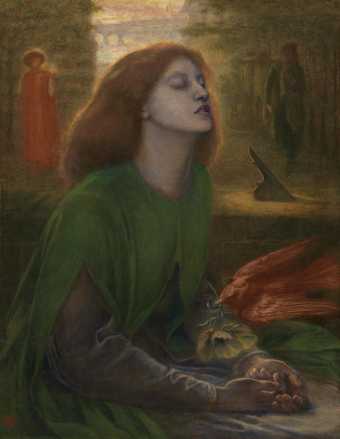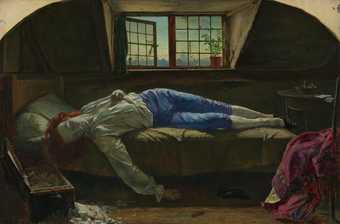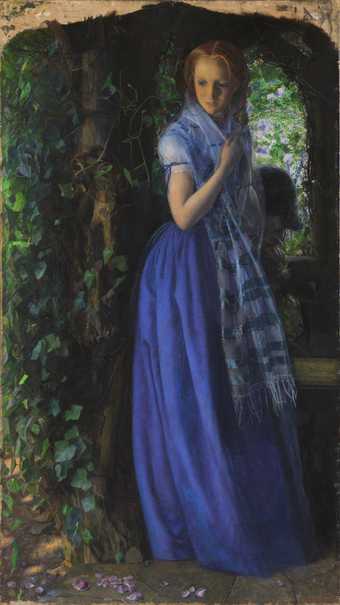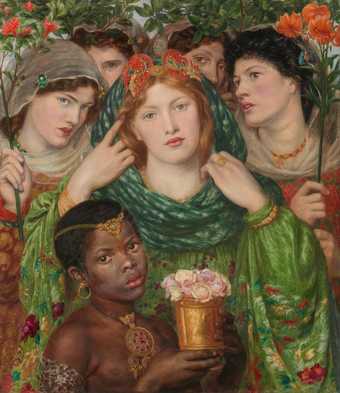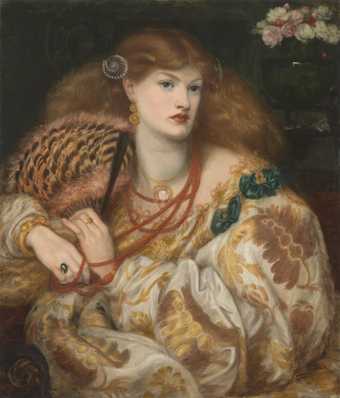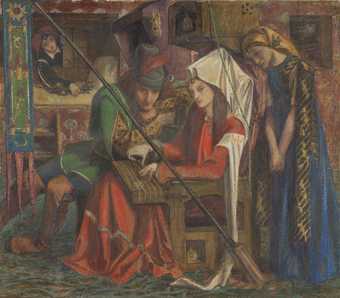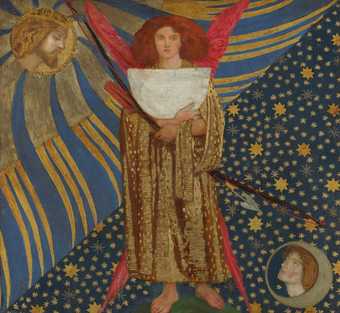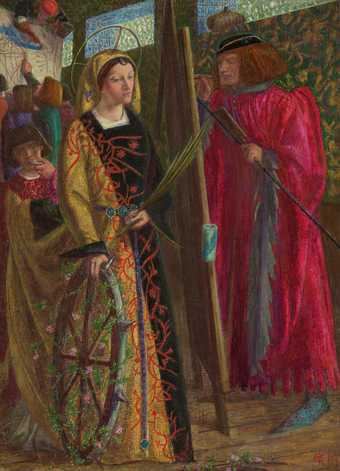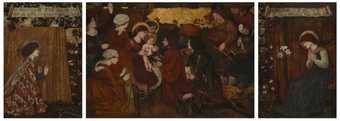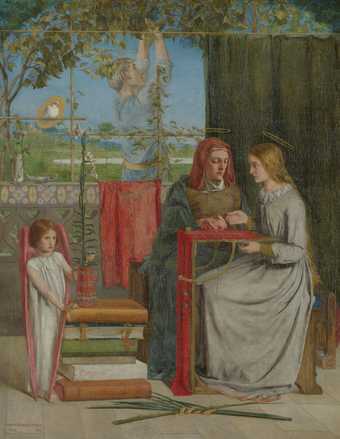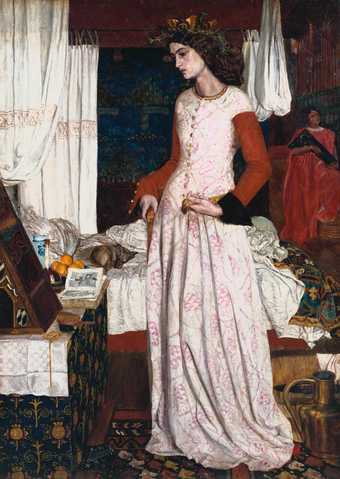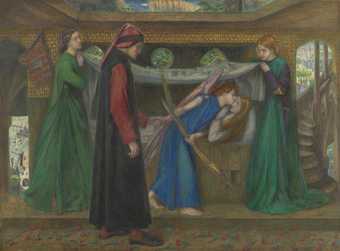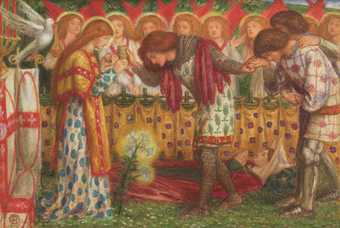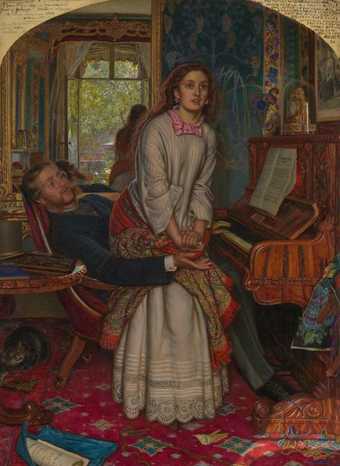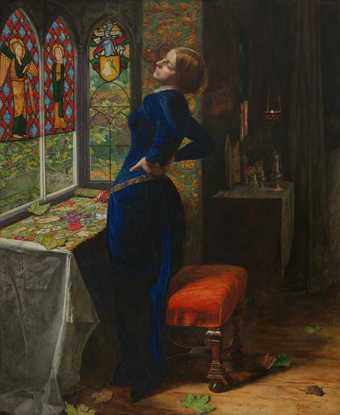
Not on display
- Artist
- Dante Gabriel Rossetti 1828–1882
- Medium
- Oil paint on canvas
- Dimensions
- Support: 724 × 419 mm
frame: 1002 × 698 × 88 mm - Collection
- Tate
- Acquisition
- Purchased 1886
- Reference
- N01210
Summary
Inspired by the work of early Renaissance artists such as Botticelli (1445-1510) and Fra Angelico (1387-1455), Rossetti sought in this work a radical reinterpretation of the Annunciation. Traditionally the Virgin was depicted in studious contemplation, reading a missal at a prie-dieu; but here Rossetti shows her rising awkwardly from a low bed, as if disturbed from sleep, while the Angel Gabriel presents her with a white lily. Both figures are dressed in white, a symbol of the virgin's purity, and the angel's role as the messenger of god is emphasised by the small white dove hovering beside him, signifying the presence of the holy spirit. Rossetti used several sitters for his figures, including his brother, William Michael, for the Angel and his sister, Christina, for the Virgin.
A companion piece showing the Virgin's death was planned, but never begun. This partly explains the tall narrow shape of the picture, which was intended as part of a diptych. Rossetti intentionally restricted his palette almost entirely to white and the three primaries. The colour blue, symbolic of heaven, is traditionally associated with the Virgin and red symbolises the blood of Christ. Rossetti even sought a red-haired model for the Virgin's head. The composition is carefully thought out: the vertical division of space, made by the blue hanging and the edge of the bed, falls almost on the Golden Section. The dove and the lily, with one bud still to break, move across this division and are the instruments of conception. Rossetti has written the date, 'March', at the bottom of the canvas, perhaps to signify the month in which the Feast of the Annunciation is held. The original frame was also inscribed with Latin mottoes, copied from a brass rubbing owned by a fellow member of the Pre-Raphaelite Brotherhood, F.G. Stephens (1828-1907).
The picture was exhibited at the National Institution in 1850 and heavily criticised, partly for its didacticism. The critic for the Athenaeum wrote that it was 'a work evidently thrust by the artist into the eye of the spectator more with the presumption of a teacher than in the modesty of a hopeful and true aspiration after excellence.' (20 April 1850, p.424) Rossetti vowed never to exhibit in public again, but he continued to work on his picture until 1853, when it was sold to Francis McCracken of Belfast, an early patron of the Pre-Raphaelites, for £50.
Further reading
Leslie Parris (ed.), The Pre-Raphaelites, London 1984, reprinted 1994, pp.72-3; reproduced p.72, in colour.
Elizabeth Prettejohn, The Art of the Pre-Raphaelites, London 2000, pp.50-1, reproduced p.50, in colour.
Virginia Surtees, The Paintings and Drawings of Dante Gabriel Rossetti (1828-1882) - A Catalogue Raisonné, 2 vols., Oxford 1971, pp.12-13, no.44, reproduced pl.29.
Frances Fowle
December 2000
Does this text contain inaccurate information or language that you feel we should improve or change? We would like to hear from you.
Display caption
In this radical reinterpretation of the Annunciation in which the angel announces to Mary that she will give birth to the Christ child, Rossetti sought a supernatural realism. Rejecting the tradition of representing the Virgin passively receiving the news, he shows her recoiling on her bed as if disturbed from sleep. Rossetti used white as the dominant colour to symbolise feminine purity, complemented by blue, a colour traditionally associated with Mary, and red, for Christ’s blood. The artist’s sister Christina posed for the Virgin and his brother William Michael for the angel.
Gallery label, November 2016
Does this text contain inaccurate information or language that you feel we should improve or change? We would like to hear from you.
Explore
- architecture(30,960)
- emotions and human qualities(5,345)
-
- chastity(9)
- fear(262)
- vulnerability(311)
- fine arts and music(3,982)
- light / lamp(264)
- individuals: female(1,698)
- individuals: male(1,841)
- Bible: New Testament(545)
-
- Annunciation(20)
- Archangel Gabriel(6)
- Virgin Mary(148)
You might like
-
Dante Gabriel Rossetti Beata Beatrix
c.1864–70 -
Henry Wallis Chatterton
1856 -
Arthur Hughes April Love
1855–6 -
Dante Gabriel Rossetti The Beloved (‘The Bride’)
1865–6 -
Dante Gabriel Rossetti Monna Vanna
1866 -
Dante Gabriel Rossetti The Tune of the Seven Towers
1857 -
Dante Gabriel Rossetti Dantis Amor
1860 -
Dante Gabriel Rossetti St Catherine
1857 -
Sir Edward Coley Burne-Jones, Bt The Annunciation and the Adoration of the Magi
1861 -
Dante Gabriel Rossetti The Girlhood of Mary Virgin
1848–9 -
William Morris La Belle Iseult
1858 -
Dante Gabriel Rossetti Dante’s Dream at the Time of the Death of Beatrice
1856 -
William Holman Hunt The Awakening Conscience
1853 -
Sir John Everett Millais, Bt Mariana
1851

